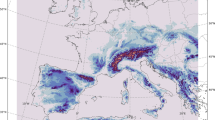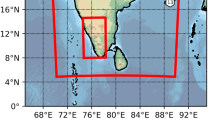Abstract
This study shows that storm surge model performance in the North Sea is mostly unaffected by the application of temporal variations of surface drag due to changes in sea state provided the choice of a suitable constant Charnock parameter in the sea-state-independent case. Including essential meteorological features on smaller scales and minimising interpolation errors by increasing forcing data resolution are shown to be more important for the improvement of model performance particularly at the high tail of the probability distribution. This is found in a modelling study using WAQUA/DCSMv5 by evaluating the influence of a realistic air-sea momentum transfer parameterization and comparing it to the influence of changes in the spatial and temporal resolution of the applied forcing fields in an effort to support the improvement of impact and climate analysis studies. Particular attention is given to the representation of extreme water levels over the past decades based on the example of the Netherlands. For this, WAQUA/DCSMv5 is forced with ERA-Interim reanalysis data. Model results are obtained from a set of different forcing fields, which either (i) include a wave-state-dependent Charnock parameter or (ii) apply a constant Charnock parameter (α C h = 0.032) tuned for young sea states in the North Sea, but differ in their spatial and/or temporal resolution. Increasing forcing field resolution from roughly 79 to 12 km through dynamically downscaling can reduce the modelled low bias, depending on coastal station, by up to 0.25 m for the modelled extreme water levels with a 1-year return period and between 0.1 m and 0.5 m for extreme surge heights.









Similar content being viewed by others
References
Ardhuin F (2016) Special project progress report—improvement of wind stress parameterization in coupled wave-atmospheric models. Tech. Rep. June, ECMWF
Batstone C, Lawless M, Tawn J, Horsburgh K, Blackman D, McMillan A, Worth D, Laeger S, Hunt T (2013) A UK best-practice approach for extreme sea-level analysis along complex topographic coastlines. Ocean Eng 71:28–39. https://doi.org/10.1016/j.oceaneng.2013.02.003
Berrisford P, Dee D, Poli P, Brugge R, Fielding K, Fuentes M, Kallberg P, Kobayashi S, Uppala S, Simmons A (2011) The ERA-interim archive. ERA Report Series 1(1):1–23
Bode L, Hardy TA (1997) Progress and recent developments in storm surge modeling. J Hydraul Eng 123 (4):315–331. https://doi.org/10.1061/(ASCE)0733-9429(1997)123:4(315)
Charnock H (1955) Wind stress on a water surface. Q J R Meteorol Soc 81:639. https://doi.org/10.1002/qj.49708135026
Coles S (2001) An introduction to statistical modeling of extreme values, 3rd edn. Springer, Berlin
Dangendorf S, Arns A, Pinto J G, Ludwig P, Jensen J (2016) The exceptional influence of storm “Xaver” on design water levels in the German Bight. Environ Res Lett 11(April):1–10. https://doi.org/10.1088/1748-9326/11/5/054001
de Bruijn C, van Meijgaard E (2005) Verification of hirlam with ecmwf physics compared with hirlam reference versions. Tech. Rep. 63
de Vries H (1991) The implementation of the WAQUA/CSM-16 model for real time storm surge forecasting. Tech. Rep TR-131, KNMI, De Bilt
Dee D P, Uppala S M, Simmons A J, Berrisford P, Poli P, Kobayashi S, Andrae U, Balmaseda M A, Balsamo G, Bauer P, Bechtold P, Beljaars A C M, van de Berg L, Bidlot J, Bormann N, Delsol C, Dragani R, Fuentes M, Geer A J, Haimberger L, Healy S B, Hersbach H, Holm E V, Isaksen L, Kollberg P, Koehler M, Matricardi M, Mcnally A P, Monge-Sanz B M, Morcrette J J, Park B K, Peubey C, de Rosnay P, Tavolato C, Thepaut J N, Vitart F (2011) The ERA-interim reanalysis: configuration and performance of the data assimilation system. Q J R Meteorol Soc 137(656):553–597. https://doi.org/10.1002/qj.828
Donelan M, Dobson F, Smith SD, Anderson RJ (1993) The dependence of sea surface roughness on wave development. https://doi.org/10.1175/1520-0485(1995)025<1905:CODOSS>2.0.CO;2
Duran-Matute M, Gerkema T, De Boer G J, Nauw J J, Gräwe U (2014) Residual circulation and freshwater transport in the Dutch Wadden Sea: a numerical modelling study. Ocean Sci 10(4):611–632. https://doi.org/10.5194/os-10-611-2014
ECMWF (2015) Part VII: ECMWF Wave model. Tech. Rep. June, ECMWF
Flather R A (2000) Existing operational oceanography. Coast Eng 41(1-3):13–40. https://doi.org/10.1016/S0378-3839(00)00025-9
Gerritsen H, de Vries H, Philippart M (1995) The dutch continental shelf model. In: Quantitative skill assessment for coastal ocean models, pp 425–467
Guan C, Xie L (2004) On the linear parameterization of drag coefficient over sea surface. J Phys Oceanogr 34:2847–2851. https://doi.org/10.1175/JPO2664.1
Gumbel E J (1958) Statistics of extremes 1958. Columbia University Press, New York
Haigh I D, Wadey M P, Gallop S L, Loehr H, Nicholls R J, Horsburgh K, Brown J M, Bradshaw E (2015) A user-friendly database of coastal flooding in the United Kingdom from 1915–2014. Scientific Data 1–13. https://doi.org/10.1038/sdata.2015.21
Horsburgh K, Wilson C (2007) Tide-surge interaction and its role in the distribution of surge residuals in the North Sea. J Geophys Res Oceans 112(8):1–13. https://doi.org/10.1029/2006JC004033
Janssen P (1991) Quasi-linear theory of wind-wave generation applied to wave forecasting. https://doi.org/10.1175/1520-0485(1991)021<1631:QLTOWW>2.0.CO;2
Janssen P, Beljaars A, Simmons A, Viterbo P (1992) The determination of the surface stress in an atmospheric model. Mon Weather Rev 120(12):2977–2985
Maat N, Kraan C, Oost W A (1991) The roughness of wind waves. Bound-Layer Meteorol 54(1-2):89–103. https://doi.org/10.1007/BF00119414
Mastenbroek C, Burgers G, Janssen P (1993) The dynamical coupling of a wave model and a storm surge model through the atmospheric boundary layer. https://doi.org/10.1175/1520-0485(1993)023<1856:TDCOAW>2.0.CO;2
Onvlee J R N (1993) The performance of drag relations in the WAQUA storm surge model. Tech rep., KNMI, de bilt
Pawlowicz R, Beardsley B, Lentz S (2002) Classical tidal harmonic analysis including werror estimates in MATLAB using t_TIDE. Comput Geosci 28(8):929–937. https://doi.org/10.1016/S0098-3004(02)00013-4
Postma H (1950) The distribution of temperature and salinity in the wadden sea. van het Koninkijk Nederlandsch Aardrijkskundig Genootschap 67:34–42
Pugh D, Woodworth P (2015) Sea-level science: understanding tides, surges, tsunamis and mean sea-level changes. Cambridge University Press 56(3):394–394. https://doi.org/10.1080/00107514.2015.1005682
Pugh D T (1996) Tides, surges and mean sea-level (reprinted with corrections), vol 5. Wiley, New York. https://doi.org/10.1016/0264-8172(88)90013-X
Ridderinkhof H (1988) Tidal and residual flows in the Western Dutch Wadden Sea I: numerical model results. Neth J Sea Res 22(1):1–21. https://doi.org/10.1016/0077-7579(88)90049-X
Smith S D, Banke E G (1975) Variation of the sea surface drag coefficient with wind speed. Q J R Meteorol Soc 101(429):665–673. https://doi.org/10.1002/qj.49710142920
Sterl A, van den Brink H, de Vries H, Haarsma R, van Meijgaard E (2009) An ensemble study of extreme storm surge related water levels in the North Sea in a changing climate. Ocean Sci 5(3):369–378. https://doi.org/10.5194/os-5-369-2009
van den Brink H W, Können G P, Opsteegh J D (2004) Statistics of extreme synoptic-scale wind speeds in ensemble simulations of current and future climate. J Clim 17(23):4564–4574. https://doi.org/10.1175/JCLI-3227.1
van Meijgaard E, van Ulft LH, Bosveld FC, Lenderink G, Siebesma P (2008) The KNMI regional atmospheric climate model RACMO version 2.1. Tech. Rep. TR-302, KNMI
van Meijgaard E, van Ulft L H, Lenderink G, de Roode S R, Timmermans R M A (2012) Refinement and application of a regional atmospheric model for climate scenario calculations of Western Europe. Tech. rep., National Research Programme Climate Changes Spatial Planning
Verlaan M, Zijderveld A, de Vries H, Kroos J (2005) Operational storm surge forecasting in the Netherlands: developments in the last decade. Philos Trans R Soc A Math Phys Eng Sci 363(1831):1441–1453. https://doi.org/10.1098/rsta.2005.1578
Zimmerman J T F (1976a) Mixing and flushing of tidal embayments in the western Dutch Wadden Sea part I: distribution of salinity and calculation of mixing time scales. Neth J Sea Res 10(2):149–191. https://doi.org/10.1016/0077-7579(76)90013-2
Zimmerman J T F (1976b) Mixing and flushing of tidal embayments in the Western Dutch Wadden Sea, part II: analysis of mixing processes. Neth J Sea Res 10(4):397–439. https://doi.org/10.1016/0077-7579(76)90019-3
Zweers N C, Makin V K, de Vries J W, Burgers G (2010) A sea drag relation for hurricane wind speeds. Geophys Res Lett 37(21):L21,811. https://doi.org/10.1029/2010GL045002
Zweers N C, Makin V K, de Vries J W, Burgers G (2012) On the influence of changes in the drag relation on surface wind speeds and storm surge forecasts. Nat Hazards 62(2):207–219. https://doi.org/10.1007/s11069-011-9989-z
Zweers N C, Makin V K, de Vries J W, Kudryavtsev V N (2015) The impact of spray-mediated enhanced enthalpy and reduced drag coefficients in the modelling of tropical cyclones. Bound-Layer Meteorol 155(3):501–514. https://doi.org/10.1007/s10546-014-9996-1
Acknowledgements
The authors would like to thank Rijkswaterstaat for providing the observational data and three anonymous reviewers for their helpful comments.
Funding
This study was funded by the Netherlands Organisation for Scientific Research (NWO) as part of the project “Impacted by Coincident Weather Extremes” (ICOWEX; grant number 869.15.017).
Author information
Authors and Affiliations
Corresponding author
Additional information
Responsible Editor: Birgit Andrea Klein
Electronic supplementary material
Below is the link to the electronic supplementary material.
Rights and permissions
About this article
Cite this article
Ridder, N., de Vries, H., Drijfhout, S. et al. Extreme storm surge modelling in the North Sea. Ocean Dynamics 68, 255–272 (2018). https://doi.org/10.1007/s10236-018-1133-0
Received:
Accepted:
Published:
Issue Date:
DOI: https://doi.org/10.1007/s10236-018-1133-0




